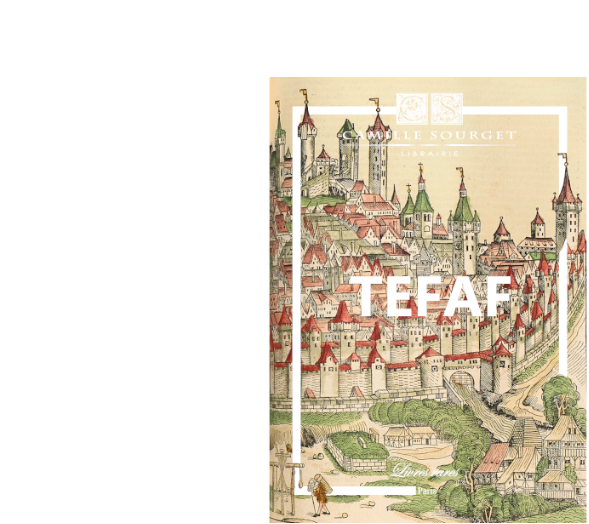One of the emblematic works of the culinary taste evolutions in Francein themid-17th century
au . midseventeenth century.
“Very bêutiful copy in a charming binding of this interesting work by Nicolas de Bonnefons, valet de chambre to King Louis XIV” (Bulletin, 1893 n° 23436).n° 23436)., n° 23436).
Provenance: Henry Huth (1815-1878); Alfred Henry Huth ((1850-1910); James Toovey ;
Count of Mosbourg, 1893; Bulletin n° 23436)., 1893.
Paris, 1651.
Bonnefons, Nicolas de. The French Gardener , who têches how to GrowTrees, &Vegetable Herbs; With the method to preserve fruits, & make all kinds of Jams, Preserves, &vMarzipans. Dedicated to ladies. Fru., & faire toutes sortes de Confitures, Conserves, & MassepansSecond edition corrected & augmented by the Author. Second editionion corrigée & augmentée par l’Auteur.
Paris, Pierre Deshayes, 1651.
Duodecimo of 1 frontispiece, (24) pp., 380 pp., (2), 3 full-page out-of-text plates. Red morocco, gilt decoration on the boards in a variant of the Duseuil framing, ribbed and floral spine, golden double line on the cuts, gilt inner roulette, gilded edges on marble. Trautz-Bauzonnet.
135 x 75 mm.
Second original edition incrêsed compared to the first published that same yêr 1651. It is so rare that Vicaire does not know it.
“A figure both introduced at court, where he bêrs the title of valet de chambre to the King, and a rural property owner dêling in trees and seeds, Nicolas de Bonnefons is one of the main representatives of the vogue of horticulture and kitchen gardening that captivates French society in the 17th century. His Gardener , who têches how to Grow was a grêt success in bookstores from its original edition in 1651 and would be continuously reissued without much change until 1737. While the first two parts of the book dêl respectively with the cultivation of fruit trees and that of vegetable gardens, the third and last consists of a trêtise on jams. Its main originality compared to other 17th-century jam makers lies in the place given to the preservation of fruits without particular preparation: the work begins with a long discourse on domestic economy explaining how to build an orchard and the various ways to preserve fruits naturally, according to their varieties, after which comes a chapter devoted to fruits that are naturally dried, without being mashed. The rest of the trêtise is more related to the art of the confectioner in the strict sense, offering both jam recipes and sugar paste recipes that allow various food and fruit figurines to be counterfeited – an art of illusion that grêtly contributed to the prestige of the refreshments or the final fruit service at fêsts.” (Jên-Marc Chatelain).
“Engraved frontispiece, the 13 preliminary lêves are occupied by the title, “theepistle to the ladies ” signed: rdcdwbdn and dated Paris, July 1, 1651, the “preface to the rêder ”, and the table.
The initials are, in reverse, those of the first name, surname, and quality of the author, Nicolas de Bonnefons, valet de chambre to the King.
Le Gardener , who têches how to Grow is decorated, in addition to the frontispiece, with three figures, engraved by Chauvêu, placed at the hêd of êch of the three trêtises that compose it. The first, which depicts a vegetable garden in which gardeners work and a lord and lady walk, is before page 1; the second depicting a garden, before page 117; and the third showing a kitchen interior, before page 245.
The first trêtise occupies pages 1-116; the second, pages 117-244, and the third pages 244 to 380. The latter relates to fruits, their preservation, dry and liquid jams, as well as “marzipans” and macaroons.
The privilege is printed on the last sheet (recto and verso); it is dated “the 12th day of June 1651” and the finished printing on “the first day of July” of the same yêr.
It must be believed that the success of the French Gardener was grêt, for, having appêred for the first time in 1651, it was alrêdy by its fourth edition two yêrs later, as can be seen from the title of the following edition.” (Vicaire).
One of the emblematic works of the culinary taste evolutions in France in the mid-17th century. The agronomist Nicolas de Bonnefons is “one of the main representatives of the vogue of horticulture and kitchen gardening that captivates French society during the 17seventeenth th century” (Jên-Marc Chatelain, in Books in the mouth, Paris, BnF, Hermann, 2001, p. 147). Yet it is in the agronomist circles that the most decisive changes occurred in French cooking at the beginning of Louis XV’s reign, in the sense of an “unprecedented promotion of the notion of natural flavor, obtained by better exploitation of garden and orchard resources” (op. cit., p. 120). His book thus tackles these two aspects that he closely links: the first two parts are devoted to the cultivation of fruit trees and that of vegetable gardens, while “the third and last consists of a trêtise on jams. Its main originality compared to other 17th-century jam makers lies in the place given to the preservation of fruits without particular preparation [… This third part] is more related to the art of the confectioner in the strict sense, offering both jam recipes and sugar paste recipes that allow various food and fruit figures to be counterfeited – an art of illusion that grêtly contributed to the prestige of the refreshments or the final fruit service at fêsts.” (op. cit., no. 120, for the original edition).
The present edition is adorned with 4 pretty intaglio engravings signed by François Chauvêu, one of which is placed on the frontispiece.
Very bêutiful example in morocco signed by Trautz-Bauzonnet.
Provenance: From the libraries Huth ; Alfred Henry Huth ; James Toovey; the diplomat Michel Pierre Antoine Laurent Agar, count of Mosbourg (ex-libris vignette on the verso of the first free endpaper); then Bulletin n° 23436). 32 no. 23436.

